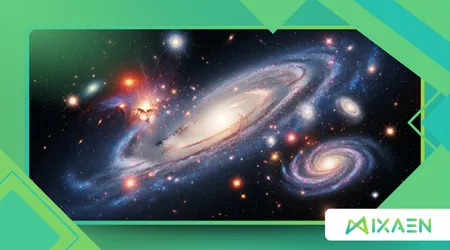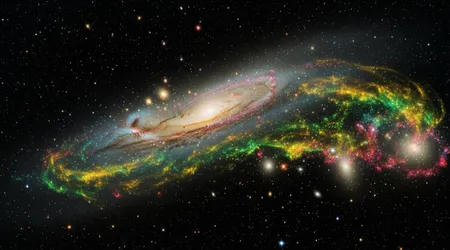Could the Universe Be a Work of Art?

Could the Universe Be a Work of Art is a question that transcends mere cosmology, pushing us into the deepest realms of philosophy, aesthetics, and theoretical physics.
Anúncios
We typically perceive the cosmos through the lens of scientific laws, seeking mechanistic explanations for phenomena like gravity and quantum entanglement.
Yet, when we step back, the sheer magnitude, complexity, and overwhelming beauty of existence challenge a purely utilitarian interpretation.
The universe reveals itself as an intricate, self-organizing system, presenting patterns, symmetries, and fine-tuning that resonate with human ideals of artistic mastery.
From the breathtaking spiral of a galaxy to the precise dance of subatomic particles, we encounter structures that evoke wonder, leading many thinkers to propose that reality may possess a profound, non-random aesthetic quality.
Anúncios
This piece argues that viewing the universe as a grand artistic expression offers a uniquely compelling framework for understanding our place within it.
What Defines the ‘Aesthetic’ in Cosmic Architecture?
True art is not random; it is the purposeful arrangement of elements to create impact, meaning, and beauty. The universe, too, exhibits an underlying, pervasive order that speaks to a principle beyond mere utility.
How Does Mathematical Symmetry Underpin Cosmic Beauty?
Symmetry is a cornerstone of both physics and classical aesthetics, representing harmony and balanced proportion.
The fundamental laws governing our cosmos, from the General Theory of Relativity to the Standard Model of particle physics, are rooted in deep mathematical symmetries.
Physicists pursue new discoveries by seeking elegant, symmetrical equations, guided by the intuition that the most beautiful theory is often the most accurate.
This preference for mathematical elegance suggests an intrinsic link between beauty and truth in the physical world.
The transition from the universe’s initial homogeneity to the structures we observe today involves symmetry breaking, which gives rise to complexity.
This process is analogous to an artist breaking the symmetry of a blank canvas to create a dynamic, detailed masterpiece. The universe moves from simple potential to complex reality.
The incredible precision required for these structures to emerge, such as the formation of the cosmic web of galaxies, highlights a carefully calibrated complexity.
This ordered yet highly detailed structure mirrors the intentional composition found in great paintings or symphonies.
++ Is Time Travel Philosophically Possible?
Why Does Fine-Tuning Suggest Intentionality or Aesthetic Preference?
The controversial “fine-tuning” argument posits that several fundamental physical constants like the strength of the electromagnetic force or the ratio of the gravitational constant are set to extraordinarily precise values.
A minute variation in any of these constants would render the universe sterile, preventing the formation of atoms, stars, or life itself.
This incredible coincidence forces us to confront three possibilities: sheer luck (the Multiverse Hypothesis), computational necessity (a survivorship bias within a simulation), or an aesthetic/intentional choice.
The third option suggests the creator, whether a deity or a sophisticated programmer, chose a reality capable of supporting maximum complexity and experience the very hallmarks of a compelling artwork.
The probability of this fine-tuning occurring by chance is often cited as astronomically low.
While not proof of an artist, the statistical improbability elevates the universe’s existence from a mundane occurrence to an extraordinary, seemingly composed event.
Cosmologists note that altering the ratio of the electromagnetic force constant to the gravitational constant by as little as one part in $10^{40}$ would prevent stars from ever forming, demonstrating an almost incomprehensible precision.
This data point underscores the narrow, delicate balance that permits our vibrant universe.

How Does the Narrative of the Universe Compare to a Masterpiece?
Beyond static structures, the cosmos tells an epic story, unfolding across billions of years, possessing a narrative arc that rivals any human-written saga.
Also read: Can We Ever Achieve a Theory of Everything?
What is the Universal Narrative of Emergence?
A great work of art tells a story: the universe offers a narrative of increasing complexity and emergent phenomena.
It begins with the simple singularity of the Big Bang and progresses through phases nucleosynthesis, star formation, the creation of heavy elements culminating in conscious life.
This journey from simplicity to self-awareness mirrors the artistic process, where raw materials (energy and fundamental particles) are shaped into profound and meaningful forms (life, consciousness). Our existence is the climax of this cosmic drama.
The interplay between destructive forces, like black holes and supernovae, and creative forces, which forge new elements and disperse them, adds dramatic tension.
This tension is necessary for any truly engaging narrative, providing the conflict and resolution that propel the story forward.
The universe constantly generates novelty, from new forms of matter under extreme pressure to biological innovations.
This relentless, unpredictable creativity is exactly what we celebrate in an artist who never repeats themselves.
Read more: Mathematical Universe Hypothesis (Max Tegmark)
Could Consciousness Be the Observer of the Art?
If the universe is an artwork, then sentient beings, particularly humans, serve as the audience and the ultimate point of introspection.
We are the mechanisms through which the cosmic process is observed, appreciated, and questioned.
Our ability to recognize beauty, from a sunset to a symmetrical equation, suggests a deep resonance with the underlying aesthetic of the cosmos. This connection is not merely functional; it is experiential and qualitative.
If the universe is a vast, continuous symphony, then our consciousness is the complex array of senses and intellect required to hear, understand, and feel the music.
Without the listener, the symphony’s existence is only potential; with the listener, it becomes a complete, realized performance.
Does This Interpretation Impact Scientific Inquiry?
Viewing the universe as a potential artwork does not invalidate scientific methods; rather, it offers a powerful philosophical motivation for pursuit of knowledge.
Why Do Scientists Prioritize Mathematical Elegance?
Scientists often use ‘beauty’ as a guide when developing new theories, a concept championed by figures like Paul Dirac.
If a theory is mathematically “ugly” or overly complicated, scientists instinctively believe it is incomplete or incorrect.
The successful discovery of the Higgs boson, predicted by an incredibly elegant mathematical structure, illustrates this principle.
The persistent faith in the simplicity and aesthetic grace of physical laws is a non-scientific bias that has repeatedly proven productive.
This quest for elegance is the scientific equivalent of an art critic seeking the unifying theme in a complex sculpture. It pushes researchers toward deep, simple, and therefore more powerful, explanations of reality.
How Does This Perspective Differ from the Simulation Hypothesis?
The Simulation Hypothesis suggests the universe is a high-fidelity computer program run by an advanced civilization. This view shares the idea of a ‘creator’ but emphasizes utility and computation.
The ‘Work of Art’ hypothesis, however, shifts the focus from efficiency and processing power to meaning, aesthetics, and experience. The programmer’s goal becomes art rather than mere data collection or ancestral simulation.
If we were a simulation, the programmers might skip simulating distant galaxies to save processing power. Yet, the universe is fully detailed, even in regions we can never observe, suggesting lavish, complete artistry.
Consider the fractal nature of coastlines and mountain ranges. They exhibit patterns (self-similarity) that are mathematically governed but result in infinite, non-repeating variations.
A simulator might use simpler algorithms, but an artist would deliberately choose this rich, aesthetically pleasing complexity.
The Spectrum of Cosmic Design Interpretation
The debate hinges on whether the universe’s order points to blind necessity or deliberate choice.
| Interpretation Model | Primary Driver | Role of Human Consciousness | Aesthetic Focus |
| Mechanistic/Naturalist | Blind Physical Laws | Accidental Byproduct | Utility and Efficiency |
| Multiverse/Anthropic | Statistical Probability | Necessary Observer | Luck of the Draw |
| Simulation Hypothesis | Computational Goal | Data Point/Construct | Algorithmic Fidelity |
| Aesthetic/Artistic | Intentional Creation/Design | Appreciator and Climax | Beauty, Symmetry, Novelty |
Conclusion: The Unanswerable Question That Elevates Humanity
Could the Universe Be a Work of Art? Ultimately, we lack the empirical tools to prove or disprove the existence of a grand, cosmic artist.
Yet, simply asking this question profoundly enriches our experience of reality. It compels us to notice the overwhelming beauty in the cosmic microwave background, the mathematical unity of forces, and the improbable miracle of life.
Could the Universe Be a Work of Art? The very possibility transforms our scientific endeavors from mere cataloging into an act of profound artistic critique.
By searching for truth and beauty, we pay the highest tribute to the masterpiece that surrounds us. What if the universe is not a problem to be solved, but a canvas to be admired?
Frequently Asked Questions (FAQ)
Does the ‘Universe as Art’ idea require a deity or ‘Creator’?
Not necessarily in a traditional religious sense.
The “Artist” could be a hyper-advanced intelligence (similar to the Simulation Hypothesis), a self-organizing principle within nature itself that favors beauty, or the ultimate expression of mathematical necessity that happens to be aesthetically pleasing.
How can we measure ‘beauty’ in a scientific context?
While beauty is subjective, its scientific proxy is often elegance or symmetry.
Scientists quantify this by looking for theories that require the fewest assumptions and parameters, possess deep mathematical symmetry (like gauge invariance), and unify disparate phenomena into a simple framework.
If the universe is art, what would be considered a ‘flaw’?
From an artistic perspective, a “flaw” could be considered any aspect that disrupts the overall harmony or is unexplained by the existing elegant laws, such as the persistent mysteries of dark matter and dark energy, which require complex, non-aesthetic additions to our equations.
These might be seen as unfinished brushstrokes awaiting completion.
Could an AI create a universe that we would consider a work of art?
Yes. If a future AI is programmed with aesthetic values a preference for complex structures, emergent novelty, and deep mathematical symmetries it could potentially generate a simulated reality that meets all the criteria we use to define a masterpiece.
The ‘Artist’ is simply the source of intentionality.
